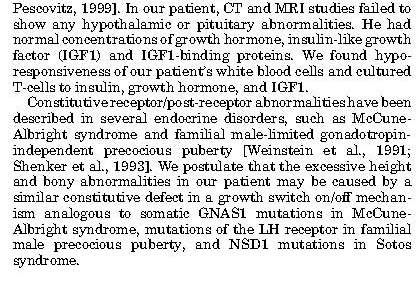In the last post I had found from forums off of other websites that there have been a few people who developed a type of gigantism without going through the normla pituitary abnormalities we are used to seeing. It seems that through certain genetic mutations, a few people have managed to develop gigantism.
The paper I would cite at the end of the previous post “The Connection Between Matt McGrory, Siah Khan, Zech Devits, And The Tallest Filipino Leads To Proteus Syndrome And Much More (Important!)” was entitled “A provisionally unique syndrome of macrosomia, bone overgrowth, macrocephaly, and tall stature”
Abstract
We report a young man with intrauterine macrosomia, macrocephaly, and bony abnormalities. Excessive growth continued throughout infancy and childhood. Bone age was advanced. He developed contractures of the large joints and was confined to a wheelchair. Extensive laboratory studies, repeated on multiple occasions were all normal. Intellectually, he was normal. His near final height was 234 cm. The constellation of findings in this patient is at variance with previously described syndromes of tall stature. We postulate that excessive size and bone overgrowth in this young man is caused by a receptor/post-receptor abnormality involving a growth on/off mechanism at the cellular level.
I would take the 4 page full file from the forum thread HERE from TheTallestMan.com website. An expanded view of the 4 pages is available from the forum. For the analysis of the study go to the bottom of the post. There is actually also a whole treasure trove of studies and articles that a serious height increase researcher can mine from to learn more about how human growth occur.
Analysis & Interpretation
The study that we find from 2005 was done on the giant Zech Devits who has passed away. He was measured (or maybe guessed) at a truly staggering 7′ 8″ tall. His large ears might have given off the fact that his height may be the result of excessive cartilage formation of hyperplasia.
From the abstract we learn that this patient had an above average sized skull, joints, joint curvature. HIs intellect seems to be intact. Besides the multiple issues the doctors and researchers might have found in his major organs, the skeletal structure showed mild contracture of the elbows and knees, the flaring of the long bones in the metaphysis region, and the curvature of the vertebrate aka thoracolumbar kyphosis. There was also thoracic dystrophy and diffuse bone dysplasia. What is really interesting to see from the charts of the blood tests is that the patient was not hypersensitive to the traditional growth factors which would cause overgrowth like insulin, growth hormones, or insulin like growth factors, IGF-1. At at the age of even an infant he was documented to have had spinal fusion. Around the age of 2 testing found that he was suffering also from severe spinal stenosis. At the age of 4.5 there was more signs of spinal atrophy.
Before even the age of 10, he was already almost 6′ 7″ (200 cms). Bone density decreased, myopia set in. From doing the bone maturity test using the Tanner method, his bone age around 9 showed that he was progressing at the average rate of most kids. His eyebrow and forehead developed, his ears grew out to be quite big, and his nasal bridge also increased. This suggest that the places of cartilage really decided to increase in size. Eventually his conditon got really bad and the people who were monitoring him decided to give him 200 mg/ week to speed up the bone maturation and fusion process.
From the discussion we would learn that while Zech was born prematurely, he was a big baby. The researchers note that his facial features resemble patients which have Sotos Syndrome or Weavers syndrome as well as Marfan’s Syndrome.
He had weakness in the upper body, moderate acne (which would suggest that his growth process of going through puberty since males start around 10-12 was normal for age range), and a very deep voice. This suggest again that his condition caused cartilage hyperplasia, since the pitch of one’s voice comes from how wide the cartilage of the windpipe (aka trachea) and voice box (aka larynx) are. The wider the speaking windpipe and voice box, from say chondrocyte hypertrophy or proliferation, the deeper one’s voice.
What seems to be ever more interesting is from the photo in the article is that his head is very large compared to the average person. It is noted that he has supra-orbital ridges or what the common person would say is a very distinct, large eyebrow ridge which juts out. His hands and feet were large (size 22-23) but his fingers seemed to be relatively short. From X-rays done, it was found that he had most of the epiphyseal growth plates already starting to fused together even at the age of 12.5 from the estrogen-like hormone treatment, including the radius, femur, and tibia.
The conclusion the physicians who were trying to figure Zech’s condition out basically are not sure whether he was suffering from Weaver’s Syndrome or Soto’s Syndrome, but only that his asymmetrical nature of growth could be from Proteus Syndrome since Proteus Syndrome leads to asymmetrical overgrowth.
I would conclude this case of gigantism and over growth with a clip on the analysis the physicians gave on his condition and what might be the cause. At this point I don’t understand what they are talking about. What is clear to realize is that for Zech, he did not suffer from some type of hypogonadism or pituitary problem like most giants, but had some other type of disorder.






Pingback: Medical Analysis On A 8 Feet Tall Iranian Giant, Siah Khan | Natural Height Growth